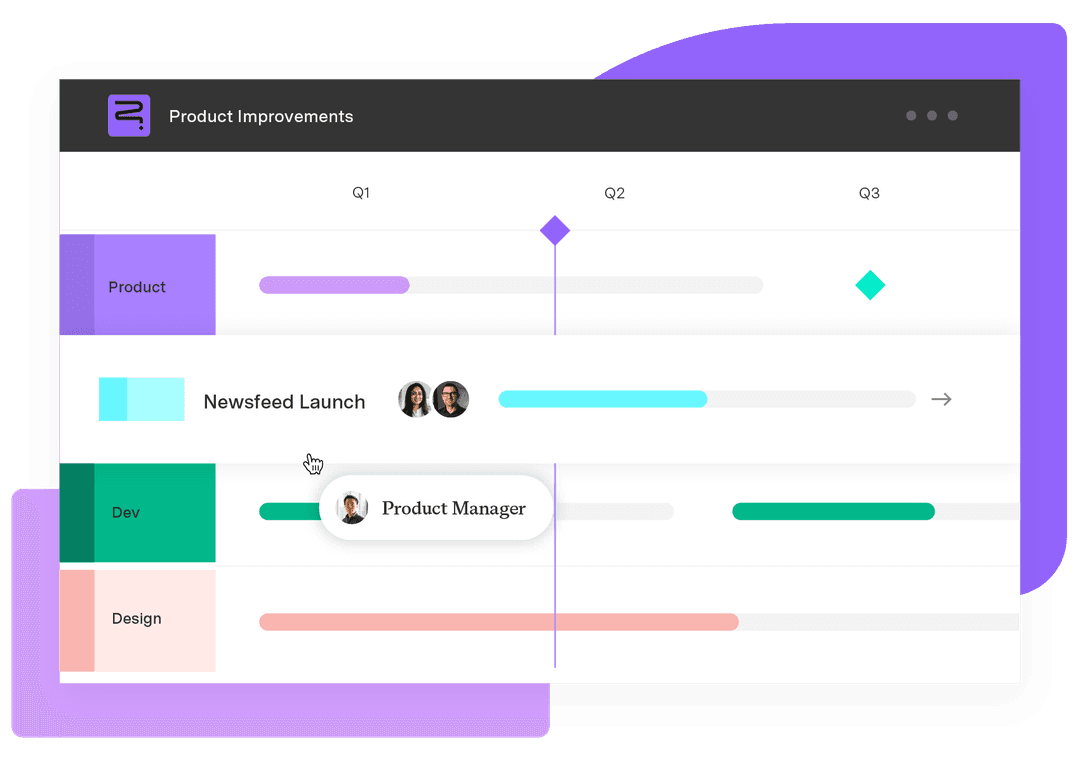Stakeholder engagement plan: Template and guide
Tempo Team
You can have the perfect project plan, the best tools, and a manageable timeline. But if you forget to loop in the right people at the right moment, your project might stall before it ever takes off.
Engaging your stakeholders is key to staying on track, whether it’s an executive who manages the budget, a team lead who flags risks early, or an end user who provides honest feedback. A strong stakeholder engagement plan helps you map out who’s involved and how to keep them in the loop.
Let’s explore what a stakeholder engagement plan is, why it matters, and how to build one step-by-step to set your project up for success.
What’s a stakeholder engagement plan?
A stakeholder engagement plan is your go-to guide for keeping the right people informed, involved, and invested in your project. It helps you identify your stakeholders and plan how and when to engage with them throughout the project. That might mean setting up regular check-ins or gathering their feedback at key moments.
A solid plan typically includes:
A list of key stakeholders (your stakeholder register)
Stakeholder level of interest and influence (usually done through stakeholder mapping)
Clear communication strategies tailored to each group
A way to track interactions, input, and next steps
It’s a core part of project stakeholder management and helps teams work better together. Whether you’re following a formal stakeholder communication plan or trying to improve collaboration, the goal is simple: creating more meaningful connections and making better decisions together.
Importance of the stakeholder engagement plan
Project success isn’t just about sticking to timelines or using the right tools – it’s also about people. A stakeholder engagement plan gives you a clear strategy to manage stakeholders throughout the project, so everyone stays aligned and invested.
Here’s why it matters:
Identify key players early
A good plan helps you pinpoint your key stakeholders from the start – the budget-holders, decision-makers, and on-the-ground experts who will move things forward or cause significant delays if left out. With tools like a stakeholder register or stakeholder analysis template, you can start strong instead of playing catch-up later.
Align your project with real business goals
Every stakeholder has different priorities. Some care about timelines, others about cost, and some just want to know how the project affects their day-to-day. A thoughtful stakeholder engagement strategy helps you uncover what matters most to each group so you can focus your efforts and connect your project to bigger organizational outcomes.
Avoid surprises and speed up decisions
It’s difficult to make decisions when you don’t have all the information. When you keep people in the dark, they’re more likely to push back, especially if something suddenly lands on their desk for approval. But when you have a smart stakeholder communication plan, you can keep them informed and ready to act when needed.
Make better decisions with real input
Your stakeholders offer valuable insights, and often, they see things your team might miss. Whether it’s through consultations or quick check-ins, creating space for feedback leads to stronger choices and fewer last-minute pivots.
Improve trust and encourage collaboration
A clear, consistent communication strategy builds transparency. People know what’s happening, how they’re involved, and where to go if something feels off. That kind of clarity reduces tension and builds stronger relationships, which is great for long-term success.
5 steps to create a stakeholder engagement plan
Whether you're managing a massive rollout or a small internal project, these five steps will help you create an effective, flexible stakeholder management plan that supports better collaboration and successful project delivery.
1. Identify stakeholders
Start by figuring out who’s affected by the project and who has influence over it. Think beyond just executives or project sponsors. Include team leads, department heads, external partners, clients, end users, and even regulators if necessary.
This is where a stakeholder register or a simple stakeholder mapping exercise can help. You’ll want to list each person or group, their role, and their level of involvement in the project.
Pro tip: Use tools like brainstorming sessions, org charts, and existing project documents to make sure no one’s left out.
2. Analyze stakeholder interest and influence
Once you know who your stakeholders are, assess their interest in the project and how much influence they have over its outcomes. A stakeholder analysis template or an interest/influence matrix can help here.
Ask questions like:
How invested is this person in the project?
What decisions can they affect?
What are their expectations or concerns?
Asking these questions helps you prioritize communication efforts and avoids wasting time or missing critical feedback.
3. Define engagement objectives
Now it’s time to set some clear goals. Ask what you want from each stakeholder, be it support, feedback, approvals, or insights. Additionally, ask what they expect from you in return.
For example:
Do you need your legal team to review documents?
Should end users test a feature before launch?
Do you want executive sponsors to advocate for funding?
By identifying these objectives early, your stakeholder engagement strategy becomes more intentional and aligned with real project needs.
4. Develop a communication strategy
Decide how you’ll communicate with each group – what channels to use, how often, and what information to share. Some stakeholders may prefer weekly status updates. Others might only need you to loop them in at major milestones.
Consider tools like:
Dashboards and project updates
Emails and newsletters
Surveys and feedback forms
One-on-one check-ins or group workshops
To make this easier, consider using automated scheduling tools. Automating recurring status updates or calendar invites ensures that key touchpoints don’t get lost in the shuffle, and it frees up your team to focus on engagement, not reminders.
5. Monitor and update the plan
No plan should be static, especially not your stakeholders' management plan. Projects evolve, and so do stakeholders' needs and expectations.
Set regular check-ins to review your trajectory. Are you meeting your engagement objectives? Is your communication working? Are any stakeholders shifting in influence or interest? Answer these questions, revisit your stakeholder mapping, and tweak your strategy to keep things running smoothly.
Stakeholder engagement plan template structure
A well-structured stakeholder engagement plan should be thorough enough to guide consistent, meaningful stakeholder engagement without being overly complicated. Here’s a flexible template structure you can adapt based on your needs.
Project overview
Summarize the project’s purpose, scope, timeline, and primary goals. This sets the context and ensures stakeholders understand what the project aims to achieve.
Stakeholder list and roles
List key stakeholders, including:
Name or group
Role/title
Department/org
Involvement level (high, medium, low)
Tip: Update this list as roles or stakeholders shift.
Engagement objectives
Define what each stakeholder needs from the project and what you need from them.
Examples:
Executive sponsor: Approve milestones, advocate internally
Product team: Share feedback during testing
Communication methods
Specify how your stakeholders prefer to communicate:
Preferred channels (email, Slack, meetings)
Frequency (weekly updates, monthly reports)
Key info they need to stay aligned
Interest/influence matrix
Map stakeholders based on their:
Interest in the project
Influence on decisions
This categorization process helps you decide who to engage closely with and who to simply inform.
Communication log
Use a comms log to track major interactions, decisions, and feedback. A well maintained log keeps everyone aligned, prevents confusion, and helps new members get up to speed fast.
Escalation and feedback
Outline:
Who handles what when issues arise
How stakeholders can give feedback (e.g., surveys, forms)
How feedback is acknowledged and addressed
Stakeholder engagement plan template example
To start, make sure to have your project title, the name and contact details of the project manager, and the date your team started. After you’ve got the basic data recorded, you can move on to the engagement plan template below.
1. Project overview
Summary of the project scope, goals, and success metrics.
Item | Details |
Project description | What’s the project about? |
Objectives | Top three to five goals |
Timeline | Start/end dates |
Success criteria | What does success look like? |
2. Stakeholder list
Identify key stakeholders, their roles, and their influence.
Name/Group | Role | Influence | Interest | Involvement |
Example: Exec lead | Budget approval | High | High | Active |
Example: QA team | Testing/feedback | Medium | High | Consulted |
3. Engagement objectives
What do you want from each stakeholder?
Stakeholder | Engagement goal | Expected outcome |
Exec lead | Keep informed on budget and milestones | Timely approvals |
QA team | Provide input during the testing phase | Quality assurance, fewer issues |
4. Communication plan
How and when will you communicate?
Stakeholder | Method | Frequency | Owner |
Exec lead | Email and Slack briefs | Monthly | Project manager |
QA team | Slack comms, standups | Biweekly | QA lead |
5. Influence/interest matrix
Use this grid to prioritize engagement.
| High interest | Low interest |
High influence | Manage closely | Keep satisfied |
Low influence | Keep informed | Monitor only |
Pro tip: Fill in roles after stakeholder mapping to more easily manage engagement styles.
6. Interaction log
Track key communications and actions.
Date | Who | How | Feedback/Notes | Next Step |
05/15 | Exec lead | Email update | Asked for budget breakdown | Send revised estimate |
05/16 | QA team | Slack message | Flagged bug in UI | Notify devs |
7. Feedback and escalation
List your top feedback channels, and have a plan about how best to escalate new info to the right stakeholders.
Feedback channels: Surveys, meetings, email
Escalation path: Team Lead → PM → Executive Sponsor
Align stakeholder visibility and accountability with Tempo
A stakeholder engagement plan helps you map out the “who” and “how.” But Tempo ensures the “when” and “what” stay on track – every single day.
With Strategic Roadmaps and Custom Charts for Jira, teams can give their stakeholders real-time visibility, track progress against objectives, and keep communication clear and accountable all in one place.
Want to simplify updates and drive better project outcomes? Start using Tempo today to keep your stakeholders aligned from kickoff to delivery.












































